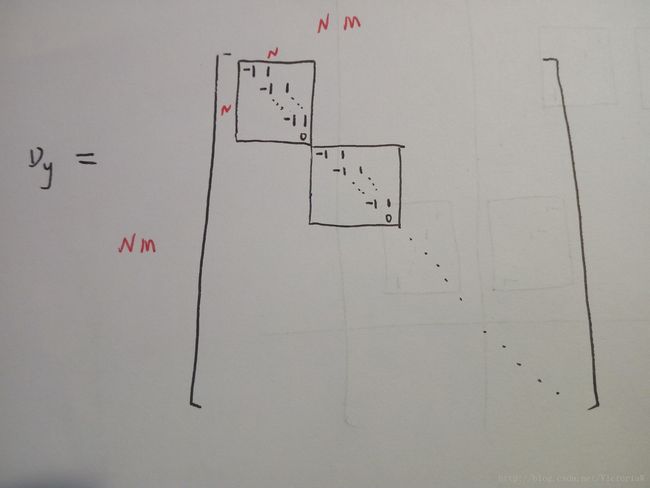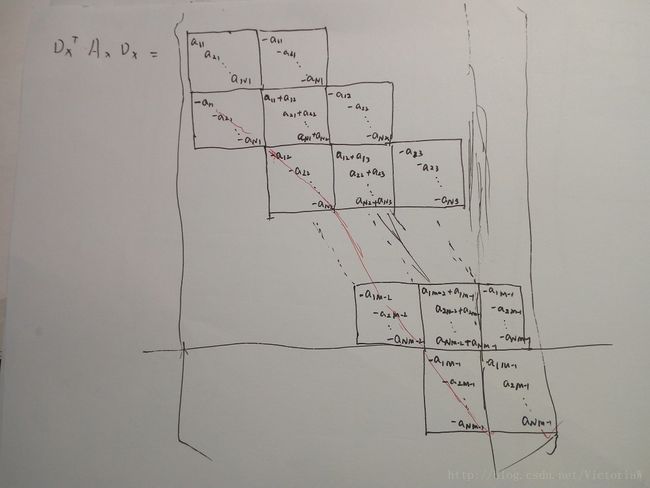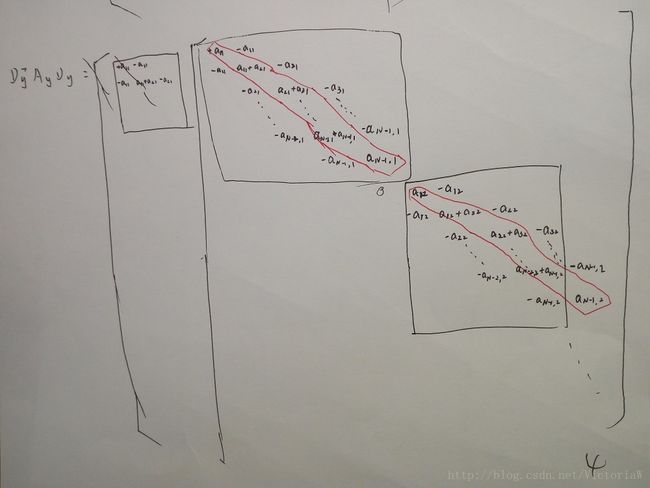计算机视觉——加权最小二乘(WLS)滤波器
Edge-Preserving Decompositions for Multi-Scale Tone and Detail Manipulation
Zeev Farbman, Raanan Fattal, Dani Lischinski, Richard Szeliski
Acm Transactions on Graphics , 2008
在关于人脸试妆的论文Digital Face Makeup by Example中,采用了本文提到的weighted least square(WLS)算法把光照层分解为结构层和细节层。这里不着重介绍本文的算法,重点解读此算法的实现代码。
给定一幅图片g(大小为N*M),想要得到新的图片u,并且一方面满足和g类似,一方面又尽可能的平滑。这个问题的数学模型:
minu∑p((up−gp)2+λ(ax,p(g)(∂u∂x)2p+ay,p(∂u∂y)2p)),(1)
其中 p 表示像素的位置,ax 和 ay 控制着不同位置上的平滑程度。
表达式(1)可以写成矩阵形式:
minu(u−g)T(u−g)+λ(uTDTxAxDxu+uTDTyAyDyu).(2)
这里 u 和g 都是 RNM 空间中的向量(矩阵按列生成的向量)。矩阵 Ax,Ay∈RNM×NM 是分别以平滑权重 ax(g) 和 ay(g) 为对角线元素的对角矩阵, Dx,Dy∈RNM×NM 是前向差分矩阵。这些矩阵的形式会在下面给出。
最优化问题(2)的解为:
u=(I+λLg)−1g,(3)
其中
Lg=DTxAxDx+DTyAyDy(4)
,为五点空间异构Laplacian矩阵。
本文取平滑权重
ax,p(g)=(∣∣∣∂l∂x(p)∣∣∣α+ϵ)−1
,
ay,p(g)=(∣∣∣∂l∂y(p)∣∣∣α+ϵ)−1.
计算Laplacian矩阵 Lg 需要用到的矩阵的形式如下(不会用Markdown打出信息这么详细的矩阵,手写勿怪):

注意,上面矩阵中的 a 是对x的,下面矩阵中的 a 是对y的。
把这两个矩阵相加就得到Laplacian矩阵 Lg 。
而作者给出的Matlab实现代码为:
function OUT = wlsFilter(IN, lambda, alpha, L)
%WLSFILTER Edge-preserving smoothing based on the weighted least squares(WLS)
% optimization framework, as described in Farbman, Fattal, Lischinski, and
% Szeliski, "Edge-Preserving Decompositions for Multi-Scale Tone and Detail
% Manipulation", ACM Transactions on Graphics, 27(3), August 2008.
%
% Given an input image IN, we seek a new image OUT, which, on the one hand,
% is as close as possible to IN, and, at the same time, is as smooth as
% possible everywhere, except across significant gradients in L.
%
%
% Input arguments:
% ----------------
% IN Input image (2-D, double, N-by-M matrix).
%
% lambda Balances between the data term and the smoothness
% term. Increasing lambda will produce smoother images.
% Default value is 1.0
%
% alpha Gives a degree of control over the affinities by non-
% lineary scaling the gradients. Increasing alpha will
% result in sharper preserved edges. Default value: 1.2
%
% L Source image for the affinity matrix. Same dimensions
% as the input image IN. Default: log(IN)
%
%
% Example
% -------
% RGB = imread('peppers.png');
% I = double(rgb2gray(RGB));
% I = I./max(I(:));
% res = wlsFilter(I, 0.5);
% figure, imshow(I), figure, imshow(res)
% res = wlsFilter(I, 2, 2);
% figure, imshow(res)
if(~exist('L', 'var')),
L = log(IN+eps);
end
if(~exist('alpha', 'var')),
alpha = 1.2;
end
if(~exist('lambda', 'var')),
lambda = 1;
end
smallNum = 0.0001;
[r,c] = size(IN);
k = r*c;
% Compute affinities between adjacent pixels based on gradients of L
dy = diff(L, 1, 1); %对L矩阵的第一维度上做差分,也就是下面的行减去上面的行,得到(N-1)xM维的矩阵
dy = -lambda./(abs(dy).^alpha + smallNum);
dy = padarray(dy, [1 0], 'post');%在最后一行的后面补上一行0
dy = dy(:);%按列生成向量,就是Ay对角线上的元素构成的矩阵
dx = diff(L, 1, 2); %对L矩阵的第二维度做差分,也就是右边的列减去左边的列,得到Nx(M-1)的矩阵
dx = -lambda./(abs(dx).^alpha + smallNum);
dx = padarray(dx, [0 1], 'post');%在最后一列的后面添加一列0
dx = dx(:);%按列生成向量,对应上面Ay的对角线元素
% Construct a five-point spatially inhomogeneous Laplacian matrix
B(:,1) = dx;
B(:,2) = dy;
d = [-r,-1];
A = spdiags(B,d,k,k);//把dx放在-r对应的对角线上,把dy放在-1对应的对角线上
e = dx;
w = padarray(dx, r, 'pre'); w = w(1:end-r);
s = dy;
n = padarray(dy, 1, 'pre'); n = n(1:end-1);
D = 1-(e+w+s+n);
A = A + A' + spdiags(D, 0, k, k);%A只有五个对角线上有非0元素
% Solve
OUT = A\IN(:);%
OUT = reshape(OUT, r, c);这段代码得到的稀疏矩阵A就是公式(3)中的 I+λLg 。这段程序和前面的推导不同之处在于平滑权重先乘以了 −λ ,但是最中的结果是一致的:对角线上用1去减,其实就是加;对于其他四个对角线,我们推导的结果是带有负号的平滑权重,然后乘以 λ ,其实就等价于直接乘以 −λ 。


